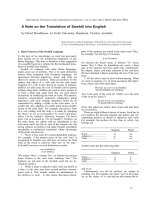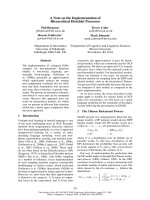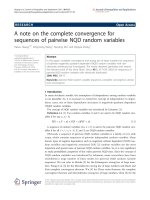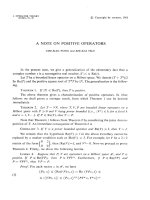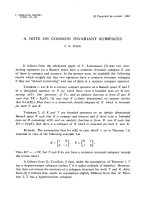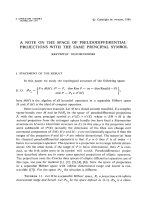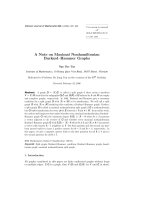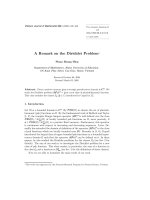Báo cáo toán học: " A Note on the Asymptotics and Computational Complexity of Graph Distinguishability" docx
Bạn đang xem bản rút gọn của tài liệu. Xem và tải ngay bản đầy đủ của tài liệu tại đây (110.2 KB, 7 trang )
A Note on the Asymptotics and Computational
Complexity of Graph Distinguishability
Alexander Russell
Department of Computer Science
University of Texas at Austin
Austin, TX 78712
Ravi Sundaram
Delta Global Trading
141 Tremont Street, 12th Floor
Boston, MA 02111
Submitted: February 2, 1998; Accepted: March 24, 1998
Abstract
A graph G is said to be d-distinguishable if there is a d-coloring of G which
no non-trivial automorphism preserves. That is, ∃χ : G →{1, ,d},
∀φ ∈ Aut(G) \{id},∃v,χ(v) = χ(φ(v)).
It was conjectured that if |G| > |Aut(G)| and the Aut(G)actiononG has no
singleton orbits, then G is 2-distinguishable. We give an example where this
fails. We partially repair the conjecture by showing that when “enough motion
occurs,” the distinguishing number does indeed decay. Specifically, defining
(G)= min
φ∈Aut(G)
φ=id
|{v ∈ G : φ(v) = v}|,
we show that when (G) > 2log
2
|Aut(G)|, G is indeed 2-distinguishable. In
general, we show that if (G)lnd>2ln|Aut(G)| then G is d-distinguishable.
There has been considerable interest in the computational complexity of the
d-distinguishability problem. Specifically, there has been much musing on the
computational complexity of the language
{(G,d):G is d-distinguishable}.
We show that this language lies in AM ⊂ Σ
P
2
∩ Π
P
2
.Weusethistoconclude
that if Dist is coNP-hard then the polynomial hierarchy collapses.
AMS Classification: Primary: 05C25; Secondary: 68Q15.
the electronic journal of combinatorics 5 (1998), #R23 2
1 Introduction
An undirected graph G is d-distinguishable if there is a d coloring of G which no
non-trivial automorphism preserves. Formally, we write ∃χ : G →{1, ,d},
∀φ ∈ Aut(G) \{id},∃v,χ(v) = χ(φ(v)),
where Aut(G) denotes the collection of automorphisms of the graph G andiddenotes
the identity map. One says that such a coloring “destroys the symmetries” of G.
Every graph G is then |G|-distinguishable and a graph is 1-distinguishable exactly
when it is rigid, i.e. |Aut(G)| = 1. The smallest d for which G is d-distinguishable
is dubbed the distinguishing number of G, denoted (G). An instantiation of this
machinery, mentioned in [1], is the problem of coloring keys on a (circular) key chain
so that one can uniquely identify each key. (In this case, one is interested in the
distinguishing number of the dihedral groups.)
A paper of Albertson and Collins [1] gracefully develops the theory of distinguisha-
bility in several directions. They conjectured that if |G| > |Aut(G)| and the action
of Aut(G)onG has no singleton orbits, then (G) = 2. Though there are graphs for
which this fails
1
, the idea that few colors suffice if every automorphism moves many
vertices can be substantiated. Specifically, for an automorphism φ ∈ Aut(G), define
the motion of φ as
(φ)=|{v ∈ G : φ(v) = v}|.
The motion of a graph G is then
(G)= min
φ∈Aut(G)
φ=id
(φ).
We show that when (G) > 2log
2
|Aut(G)|, G is 2-distinguishable. More generally,
when (G)lnd>2ln|Aut(G)|, G is d-distinguishable.
Another natural question is that of the computational complexity of the graph
distinguishability problem (see the discussion in [1]). Specifically, one would like to
place the language
Dist = {(G,d): (G) ≤ d},
as low in the natural hierarchy of complexity classes as possible. There is no obvious
NP algorithm for this language; the only immediate conclusion is that DIST ∈ Σ
P
2
.
We show that Dist ∈ AM ⊂ Π
P
2
∩ Σ
P
2
.
2 Graphs with Large Motion can be Distinguished with Few
Colors
We now return to the first theorem advertised in the introduction, namely
1
Select a large rigid graph H and let G
H
be the graph formed by the disjoint union of K
3
and 3
copies of H. Then Aut(G
H
)=S
3
×
S
3
, G
H
has no one cycles, (G
H
) = 3, and
|
G
H
|
can be arbitrarily
large.
the electronic journal of combinatorics 5 (1998), #R23 3
Theorem 1. If (G) > 2log
2
|Aut(G)| then G is 2-distinguishable.
Anticipating the proof, we define the cycle norm as follows: decomposing an
automorphism φ into a product of disjoint cycles
φ =(v
11
v
12
v
1l
1
)(v
21
v
2l
2
) (v
k1
v
kl
k
),
the cycle norm of φ is the quantity
(φ)=
k
i=1
(l
i
−1).
The cycle norm is relevant to graph distinguishability in the following sense. Sup-
pose that a graph G is randomly two-colored by independently assigning each vertex
a color uniformly from {red,black}. Then the probability that every cycle of an
automorphism φ is monochromatic is exactly 2
− (φ)
. When this event occurs, the
automorphism φ preserves the coloring so chosen.
For convenience, the cycle norm of a graph G is defined
(G)= min
φ∈Aut(G)
φ=id
(φ).
Notice that for any automorphism, (φ) ≥ (φ)/2. Of course, then (G) ≥ (G)/2.
With this observation, Theorem 1 above is an easy consequence of the following
theorem:
Theorem 2. If (G)lnd>ln|Aut(G)| then G is d-distinguishable.
Proof. We study the behavior of a random d-coloring of G, the probability distribu-
tion given by selecting the color of each vertex independently and uniformly in the set
{1, ,d}. Fix an automorphism φ = id and consider the bad event that the random
coloring χ is in fact preserved by φ: an easy calculation shows that
Pr
χ
[∀v,χ(v)=χ(φ(v))] = (
1
d
)
(φ)
≤ (
1
d
)
(G)
.
Collecting together these bad events, we have
Pr
χ
[∃φ =id,∀v,χ(v)=χ(φ(v))] ≤|Aut(G)|(
1
d
)
(G)
.
The hypothesis of the theorem is exactly that this quantity is less than one, in which
case there exists a coloring χ for which ∀φ =id,∃v,χ(v) = χ(φ(v)), as desired.
For a delightful survey of the probabilistic method, of which the above is an
example, see [2].
It is interesting to notice that the above theorem is actually tight in the case of the
dihedral groups D
3
,D
4
, mentioned in the introduction (and in [1]). (The answers
are (D
3
)=3, (D
4
)=4, (D
5
)=2, (D
6
)=2, )
the electronic journal of combinatorics 5 (1998), #R23 4
3 Dist ∈ AM
Though we will discuss the definition of AM in some detail, for a general introduction
to complexity theory and detailed discussions of the polynomial time hierarchy and
AM, we refer the reader to [9] and [4, 5].
The polynomial time hierarchy is the “polynomial time bounded variant” of the
Kleene hierarchy of recursive function theory. One defines Σ
P
0
=Π
P
0
= P, and, in
general, L
∈
Σ
P
k
if there is a polynomial p and D
∈
Π
P
k−1
for which
L =
{
w :
∃
π,
|
π
|≤
p(
|
w
|
),
w,π
∈
D
}
.
Finally, define the class Π
P
k
to consist of all languages L for which L
∈
Σ
P
k
.Above,
the notation
·
,
·
refers to some canonical pairing function. With these definitions,
NP = Σ
P
1
,coNP=Π
P
1
,andtheclassesΣ
P
k
and Π
P
k
form a neat hierarchy containing
P and lying inside PSPACE.
Considering the quantifier alternation in the definition of the distinguishability
problem, it is not surprising that Dist
∈
Σ
P
2
, as an easy argument shows. Our goal
here is to show that Dist
∈
AM
⊂
Σ
P
2
∩
Π
P
2
.
AM is the class of languages for which there are Arthur–Merlin games (see [3]).
Intuitively, an Arthur–Merlin game for a language L is played by two players, Arthur,
equipped with a random coin and only modest (polynomial-time bounded) computing
power and Merlin, who is computationally unbounded. Both Arthur and Merlin are
supplied with a word x, and the goal of the game is for Arthur to determine if x
∈
L.
Arthur, based on his coin flips, may ask Merlin a constant number of questions, and,
having heard Merlin’s answers, must then decide to accept that x
∈
L or reject this
statement. Of course, a natural question for Arthur to ask is, “x
∈
L?” Unfortunately,
rather than being the trustworthy advisor we might hope, Merlin actually has a vested
interest in seeing that Arthur accept the predicate. An Arthur–Merlin game, then, is
a strategy for Arthur to follow in his questioning of Merlin so that:
•
When x
∈
L, regardless of Arthur’s coin tosses (which may determine the ques-
tions he asks of Merlin under this strategy), Merlin can answer satisfactorily,
convincing Arthur to accept that x
∈
L.
•
When x
∈
L, regardless of way in which Merlin answers, the discussion ends with
Arthur rejecting that x
∈
L a constant fraction of the time. (The probability
distribution is taken over Arthur’s coin tosses.)
The number of questions which Arthur is allowed to ask may depend on the language,
but not the specific input. Furthermore, the entire conversation must have length
polynomial in the length of the input. In the above model, Arthur’s coin flips are
public– Merlin can see them.
Hopefully, it is clear from this vague definition that every language in NP has an
(easy) Arthur-Merlin game. We will show that there is an Arthur-Merlin game for
the language Dist. First, a formal definition:
the electronic journal of combinatorics 5 (1998), #R23 5
Definition 1. For a function M : {0,1}
∗
→{0,1}
p
, and random variables X
1
,X
2
, ,X
R
∈
{0,1}
p
,let
M
X
=(M(X
1
),M(X
1
,X
2
), ,M(X
1
, ,X
R
)).
AM consists of those languages L for which there exists a constant R,apolynomial
p, and a polynomial time bounded Turing machine A so that:
• x ∈ L ⇒∃M : {0,1}
∗
→{0,1}
p(|x|)
,
Pr
{X
i
}
[A(x, X
1
, ,X
R
,M
X
) accepts] = 1,
where the X
i
are independent uniform random variables on {0,1}
p
.
• x ∈ L ⇒∀M : {0,1}
∗
→{0,1}
p(|x|)
,
Pr
{X
i
}
[A(x,X
1
, ,X
R
,M
X
) accepts] ≤
1
2
,
where the X
i
are independent uniform random variables on {0,1}
p
.
We start by showing that the language of rigid graphs is in AM. Let
Rigid = {G : |Aut(G)| =1} .
Theorem 3. Rigid ∈ AM
Proof. The proof is an easy adaptation of the result of [7, 8] that the language
NGI = {(G
1
,G
2
):G
1
G
2
}
is in AM . In the formulation of AM given above, Merlin observes Arthur’s coin tosses.
This scenario is aptly dubbed the “public” coin model. In fact, in the formalization
above, Arthur’s questions to Merlin are exactly his coin tosses (the random variables
X
i
in the above definition). Since Arthur is deterministic aside from his coin tossing,
any question he might wish to have answered can be anticipated and duly answered by
Merlin. In the alternative model, involving “private” coin tosses, Arthur’s questions
may not completely reveal the coins he has tossed so far. It is rather remarkable that
the two models are in fact equivalent [8]. We shall allow ourselves the flexibility of a
private coin in our constructions. Our goal is to show that Rigid ∈ AM. Given input
G =([n],E), consider the following protocol:
1. Arthur generates a random permutation σ ∈ S
n
, and sends Merlin the graph
G
σ
=([n],E
σ
), where
E
σ
= {(σ(u),σ(v)) : (u,v) ∈ E}.
2. Arthur expects Merlin to respond with an element of S
n
. Given any other
response, Arthur rejects. Upon receiving τ ∈ S
n
. Arthur accepts exactly if
τ = σ.
the electronic journal of combinatorics 5 (1998), #R23 6
Notice that when G is rigid, there is a unique isomorphism between G and G
σ
,so
that Merlin does indeed have a strategy which always convinces Arthur to accept.
Suppose instead that G is non-rigid so that |Aut(G)| > 1. In this case, there are
exactly |Aut(G)| isomorphisms between G and G
σ
and, furthermore, conditioned on
Arthur asking the question G
σ
to Merlin, each of these isomorphisms is equally like to
be the one used by Arthur to construct G
σ
. Hence no strategy of Merlin can induce
accepting behavior in Arthur for more than a |Aut(G)|
−1
≤
1
2
fraction of Arthur’s
coin tosses.
Theorem 4. Dist ∈ AM.
Proof. Let (G =([n],E),k) be the common input, and consider the following protocol:
1. Arthur expects Merlin to send him χ : G → [k], a k-coloring of G.Onanyother
message, Arthur rejects.
2. Arthur builds a new graph G
follows. Starting with G, Arthur adds for every
vertex v of G afresh(n + χ(v))-clique, called K
v
. Each vertex v,asidefrom
maintaining its old connections inside G is attached to each vertex of K
v
.An
easy argument shows that the isomorphisms of G
are in one-to-one correspon-
dence with isomorphisms of G which fix χ. Specifically, if χ destroyed all of the
symmetries of G, G
is rigid. Arthur now uses the protocol described above for
Rigid.
It is now easy to check that this protocol satisfies the requirements in the definition
of AM.
Based on constructions like those of [12, 10, 11], one has AM ⊂ Σ
P
2
∩ Π
P
2
,com-
pleting the claim in the introduction.
One naturally wonders at the relationship of Dist to more familiar classes such as
NP and coNP. In this direction, applying the machinery of [6], we can argue that it is
unlikely that Dist is coNP-hard. Specifically, from [6], we have the following theorem:
Theorem 5. If coNP ⊂ AM, then the polynomial hierarchy collapses to Σ
P
2
,specifi-
cally Σ
P
k
⊂ Σ
P
2
for all k.
In our case, were Dist to be coNP-complete, coNP ⊂ AM, and we could apply the
above theorem. Complementing, this shows that the language
Robust = {(G,k):∀χ : G → [k],∃γ ∈ Aut(G) \{id},γ preserves χ}
is unlikely to be NP hard.
4AnOpenProblem
An outstanding open question is whether the language Dist is in fact NP-hard.
the electronic journal of combinatorics 5 (1998), #R23 7
5 Acknowledgments
We thank Karen Collins for originally introducing us to the problem during her en-
gaging talk at M.I.T. and several helpful discussions.
References
[1] Michael O. Albertson and Karen L. Collins. Symmetry breaking in graphs.
Electronic Journal of Combinatorics, 3, 1996. R18.
[2] Noga Alon and Joel H. Spencer. The Probabilistic Method. John Wiley & Sons,
Inc., 1992.
[3] L´aszl´o Babai and Shlomo Moran. Arthur-merlin games: a randomized proof
system, and a hierarchy of complexity classes. Journal of Computer and System
Sciences, 36(2):254–276, 1988.
[4] Jos´eLuisBalc´azar, Josep D
´
iaz, and Joaquim Gabarr´o. Structural Complexity I,
volume 11 of EATCS Monographs on Computer Science. Springer-Verlag, Berlin,
1988.
[5] Jos´eLuisBalc´azar, Josep D
´
iaz, and Joaquim Gabarr´o. Structural Complexity
II, volume 22 of EATCS Monographs on Computer Science. Springer-Verlag,
Berlin, 1990.
[6] RaviBoppana,JohanH˚astad, and Stathis Zachos. Does co-NP have short inter-
active proofs? Information Processing Letters, 25:127–132, 1981.
[7] Shafi Goldwasser, Silvio Micali, and Charles Rackoff. The knowledge complex-
ity of interactive proof systems. SIAM Journal of Computing, 18(1):186–208,
February 1989.
[8] Shafi Goldwasser and Michael Sipser. Private coins versus public coins in inter-
active proof systems. Advances in Computing Research, 5:73–90, 1989.
[9] Johannes K¨obler, Uwe Sch¨oning, and Jacobo Tor´an. The Graph Isomorphism
Problem: Its Structural Complexity. Progress in Theoretical Computer Science.
Birkh¨auser, Boston, 1993.
[10] Clemens Lautemann. BPP and the polynomial hierarchy. Information Processing
Letters, 17:215–217, 1983.
[11] Alexander Russell and Ravi Sundaram. Symmetric alternation captures BPP.
Computational Complexity, 6, 1996.
[12] Michael Sipser. A complexity theoretic approach to randomness. In Proceedings
of the Fifteenth Annual ACM Symposium on Theory of Computing, pages 330–
335, Boston, Massachusetts, 25–27 April 1983.
